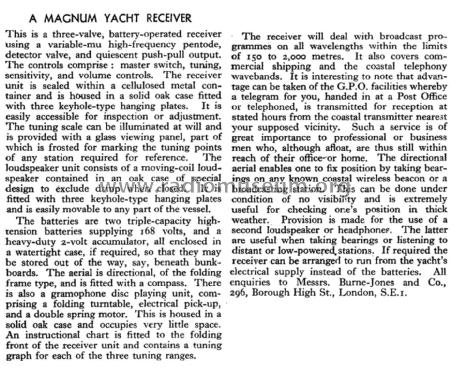Magnum Yacht Receiver
Magnum (brand) Burne-Jones & Co. Ltd.; London
- Pays
- Royaume Uni
- Fabricant / Marque
- Magnum (brand) Burne-Jones & Co. Ltd.; London
- Année
- 1936 ?
- Catégorie
- Radio - ou tuner d'après la guerre 1939-45
- Radiomuseum.org ID
- 354486
- No. de tubes
- 3
- Lampes / Tubes
- Principe général
- Récepteur TRF - sans réaction (pas régénératif)
- Gammes d'ondes
- PO et GO
- Particularités
- Tourne disque sans changeur
- Tension / type courant
- Batteries / Alim. BT séparée avec fiche / 2 x 168, 2 Volt
- Matière
- Matériel spécial, décrit dans les notes
- De Radiomuseum.org
- Modèle: Magnum Yacht Receiver - Magnum brand Burne-Jones & Co.
- Forme
- Chassis (pour intégration dans meuble)
- Remarques
-
Magnum Yacht Receiver
This is a three-valve, battery-operated receiver using a variable-mu high-frequency pentode, detector valve, and quiescent push-pull output.
The controls comprise a master switch, tuning, sensitivity, and volume controls. The receiver unit is sealed within a cellulose metal container and is housed in a solid oak case fitted with three keyhole-type hanging plates. It is easily accessible for inspection or adjustment. The tuning scale can be illuminated at will and is provided with a glass viewing panel, part of which is frosted for marking the tuning points of any station required for reference. The loudspeaker unit consists of a moving-coil loudspeaker contained in an oak case of special design to exclude dampness when closed. It is fitted with three keyhole-type hanging plates and is easily movable to any part of the vessel.
The batteries are two triple-capacity high-tension batteries supplying 168 volts, and a heavy-duty 2-volt accumulator, all enclosed in a watertight case, if required, so that they may be stored out of the way, say, beneath bunk boards.
The aerial is directional, of the folding frame type, and is fitted with a compass. There is also a gramophone disc playing unit, comprising a folding turntable, electrical pick-up, and a double spring motor. This is housed in a solid oak case and occupies very little space.
An instructional chart is fitted to the folding front of the receiver unit and contains a tuning graph for each of the three tuning ranges. The receiver will deal with broadcast programs on all wavelengths within the limits of 150 to 2,000 metres. It also covers commercial shipping and the coastal telephony wavebands.
It is interesting to note that advantage can be taken of the G.P.O. facilities whereby a telegram for you, handed in at a Post Office or telephoned, is transmitted for reception at stated hours from the coastal transmitter nearest your supposed vicinity. Such a service is of great importance to professionals or businessmen who, although afloat; are thus still within reach of their office or home. The directional aerial enables one to fix position by taking bearings on any known coastal wireless beacon or broadcasting station. This can be done under condition of no visibility and is extremely useful for checking one's position in thick weather. Provision is made for the use of a second loudspeaker or headphones. The latter are useful when taking bearings or listening to distant or low-powered. stations.
If required, the receiver can be arranged to run from the yacht's electrical supply instead of the batteries.
- Littérature
- -- Original prospect or advert (World Radio Jul 1935, Page 24)
- Auteur
- Modèle crée par Gary Cowans. Voir les propositions de modification pour les contributeurs supplémentaires.
- D'autres Modèles
-
Vous pourrez trouver sous ce lien 23 modèles d'appareils, 17 avec des images et 1 avec des schémas.
Tous les appareils de Magnum (brand) Burne-Jones & Co. Ltd.; London
